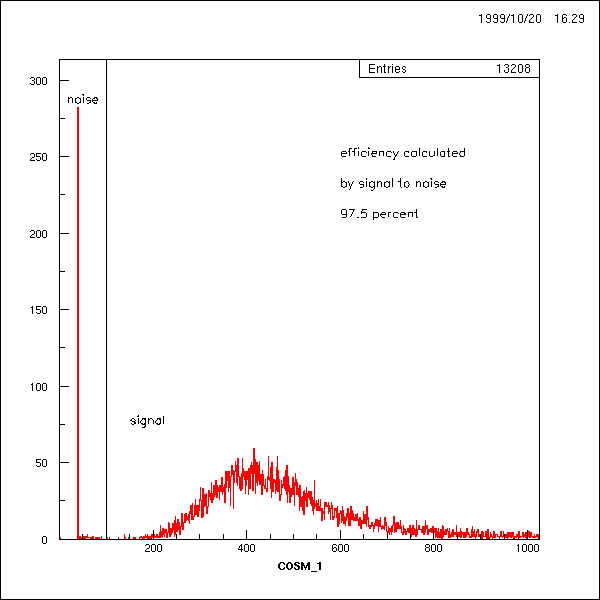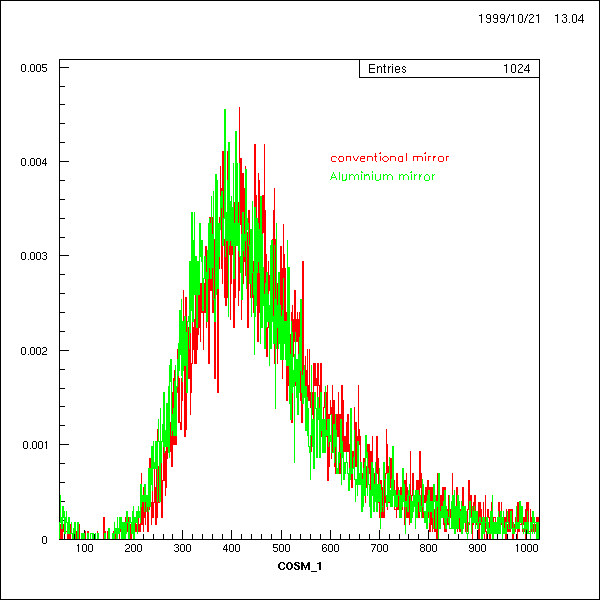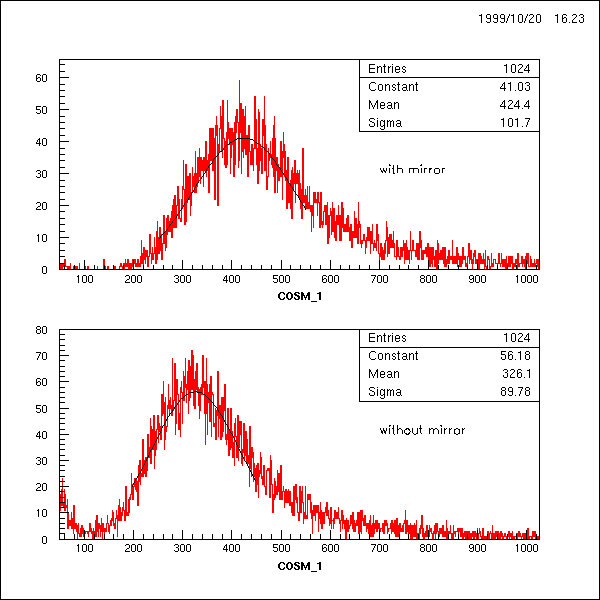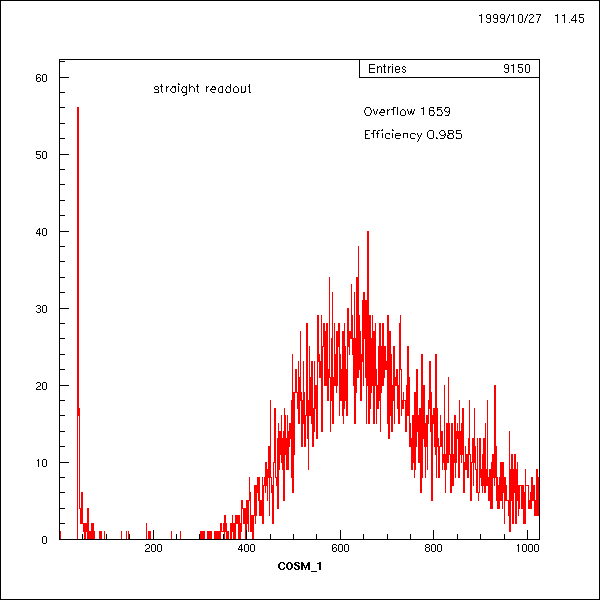

For the front- and backside of our Cosmic Veto counter we are strongly limited in space. The usual readout as we use it e.g. for the top counter can not be used. The orientation of the photomultiplier tube has to be rectangular to the CV surface (see figure 1). A test was set up at PSI to study which efficiency we can achieve by the rectangular readout. The geometry of the test piece and the cover box is shown in figure 2. The 'classical' setup of this test can be found in figure 3.
Figure 1: On top you can see the 'normal' readout for our Cosmic Veto counters. The lower one shows how we want to guide the light out rectangular by a mirror. The mirror can be exchanged easily to find the best material. Test have been made by a conventional mirror, Aluminium foil, aluminized Kapton and without mirror (just using internal total reflection).
Figure 2: Geometry of the used piece of scintillator. The scintillator together with the wavelength shifter (WLS) is inside a solid box. The WLS can be exchanged for comparison between straight and rectangular readout. The scintillators are wrapped with Al foil, as it is in our CV top counter.
Figure 3: Test setup. The Scintillator counter has two trigger counters on top and on bottom (parameters see below).

PM tube: Burle S83062E (as Pibeta Plastic Veto readout)
HV: 1280 V
optical coupling to the WLS: optical compound Dow Corning Q2-3067
Trigger counters:
Size: 20 x 75 x 95 mm^3
PM tube: Hamamatsu R 5600 directly attached to the scintillator
HV: ~920 V
discriminator threshold: 30 mV
A coincidence between the two small counters indicates the pass of a cosmic muon through the test counter. The coincidence opens a gate of 80 ns width for the ADC (LeCroy 2249 A). The analog signal from the test counter comes ~5 ns later and goes to the input of the ADC.
The measured coincidence rate is ~0.75 Hz, which is what we expect from the size of the trigger counters.
For Data aquisition LabView is used.

First of all the readout efficiency has been measured. You can extract the efficiency from the ADC spectrum, where we have a sharp pedestal on the left, separated from the signal amplitude histogram. The ratio of the number of counts with an amplitude which is above the pedestal, to the total number of counts give you the efficiency. Pedestal will be filled, when a particle passes the test counter (indicated by the trigger coincidence), which will not cause a signal in the test counter PM tube (see figure 4).
The choice of the mirror material depends on the efficiency and the amplitude of the signals, which means a better light collection. The comparison of 2 normalized spectra is shown in figure 5. This shows, that the spectra for different mirror materials look more or less the same. A variation of the efficiency is due to statistical fluctuations and maybe small change of the optical coupling of the Burle tube.
The effect of the mirror can be seen in figure 6, where the spectra of the readout with and without a mirror is shown. With a mirror you can win ~34 percent of light.

Figure 4: Efficiency measurement for a conventional mirror. The efficiency is calculated by the integral content of the histogram to the number of 'pedestal hits'. The best efficiency of 97.5 percent was measured (all > 94%). This might be less in our experiment due to the attenuation length of our setup.

Figure 5: Comparison of the normalized spectra for two mirror materials - conventional mirror and Aluminium foil. The spectra look more or less identical. There is no strong variation in the efficiency. It was always measured between 95 and 97.5 percent.

Figure 6: Comparison between the use of a mirror and without a mirror, where you will have only internal total reflection. You will win ~34 percent of light by the mirror.
A comparison between the straight and the rectangular readout has been measured. Figure 7 shows the raw spectrum from the same counter with straight readout (as Cosmic Veto Top counter), everything else just the same (just the WLS exchanged). From this data one can calculate an efficiency of 98.5%.
Figure 8 shows the comparison of the histograms for a straight and a rectangular readout with a conventional mirror. The ratio of the peak positions (after pedestal subtraction) is 64.5%. This means, that we can get 64% of the light by the use of a mirror instead a straight readout.

Figure 7: ADC histogram for the straight readout. From the signal to pedestal content ratio one calculates an efficiency of 98.5%.
Figure 8: Comparison of the ADC spectra of a straight and a mirrored rectangular readout. For the rectangular readout we can get 64% of the light we get from the straight readout.

The rectangular readout of the front- and backside counters of the Cosmic Veto is possible. We can collect 64% of the light which we can get from a comparable straight readout architecture. Therefore the efficiency drops from 98.5% to ~95%. The choice of the mirror material is not critical. The light collection for a conventional mirror and Aluminium foil is about the same. The use of a mirror gives us ~34% more light as without a mirror (just using internal total reflection).

H.P. Wirtz , 21-Oct-1999
last update: 28-Oct-1999

Paul Scherrer Institut (PSI) WWW Information Services, Home
Page
Pion Beta Experiment Home Page